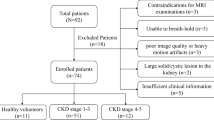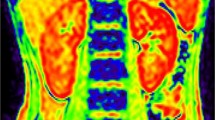Abstract
Objective
Blood oxygenation level dependent (BOLD) MRI technique is used to evaluate changes in intra-renal oxygenation in chronic kidney disease (CKD). The purpose of this study was to evaluate if the novel twelve layer concentric objects (TLCO) method has advantages over the manually defined regions of interest (ROI) analysis.
Methods and materials
Existing renal BOLD MRI data acquired before and after furosemide on a 3 T scanner from 41 CKD patients and 13 age matched healthy controls were analyzed using TLCO method and compared with previously reported ROI analysis.
Results
Regional R2* measurements were strongly correlated between the two methods, while ΔR2* was moderately correlated. Medullary R2* by ROI analysis showed higher values compared to R2*_Inner by TLCO, probably due to the contributions from the cortex to R2*_Inner. R2*_Slope and Δ(R2*_Slope), unique parameters based on the TLCO method provided the most significant differences between stage 3a CKD patients and controls and were correlated with eGFR.
Discussion
There was a high degree of agreement between the two methods in terms of regional R2* measurements and both methods did not show differences between moderate CKD patients and controls. However, R2*_Slope and Δ(R2*_Slope) showed the largest sensitivity in distinguishing CKD from controls.


Similar content being viewed by others
References
Li LP, Ji L, Santos E, Dunkle E, Pierchala L, Prasad P (2009) Effect of nitric oxide synthase inhibition on intrarenal oxygenation as evaluated by blood oxygenation level-dependent magnetic resonance imaging. Invest Radiol 44(2):67–73
Hofmann L, Simon-Zoula S, Nowak A, Giger A, Vock P, Boesch C, Frey FJ, Vogt B (2006) BOLD-MRI for the assessment of renal oxygenation in humans: acute effect of nephrotoxic xenobiotics. Kidney Int 70(1):144–150
Epstein FH, Prasad P (2000) Effects of furosemide on medullary oxygenation in younger and older subjects. Kidney Int 57(5):2080–2083
Prasad PV, Epstein FH (1999) Changes in renal medullary pO2 during water diuresis as evaluated by blood oxygenation level-dependent magnetic resonance imaging: effects of aging and cyclooxygenase inhibition. Kidney Int 55(1):294–298
Inoue T, Kozawa E, Okada H, Inukai K, Watanabe S, Kikuta T, Watanabe Y, Takenaka T, Katayama S, Tanaka J, Suzuki H (2011) Noninvasive evaluation of kidney hypoxia and fibrosis using magnetic resonance imaging. J Am Soc Nephrol 22(8):1429–1434
Prasad PV, Li LP, Thacker JM, Li W, Hack B, Kohn O, Sprague SM (2019) Cortical perfusion and tubular function as evaluated by magnetic resonance imaging correlates with annual loss in renal function in moderate chronic kidney disease. Am J Nephrol 49(2):114–124
Prasad PV, Thacker J, Li LP, Haque M, Li W, Koenigs H, Zhou Y, Sprague SM (2015) Multi-parametric evaluation of chronic kidney disease by MRI: a preliminary cross-sectional study. PLoS ONE 10(10):e0139661
Pruijm M, Hofmann L, Piskunowicz M, Muller ME, Zweiacker C, Bassi I, Vogt B, Stuber M, Burnier M (2014) Determinants of renal tissue oxygenation as measured with BOLD-MRI in chronic kidney disease and hypertension in humans. PLoS ONE 9(4):e95895
Pruijm M, Milani B, Pivin E, Podhajska A, Vogt B, Stuber M, Burnier M (2018) Reduced cortical oxygenation predicts a progressive decline of renal function in patients with chronic kidney disease. Kidney Int 93(4):932–940
Sugiyama K, Inoue T, Kozawa E, Ishikawa M, Shimada A, Kobayashi N, Tanaka J, Okada H (2018) Reduced oxygenation but not fibrosis defined by functional magnetic resonance imaging predicts the long-term progression of chronic kidney disease. Nephrol Dial Transplant. https://doi.org/10.1093/ndt/gfy324
Zhou H, Yang M, Jiang Z, Ding J, Di J, Cui L (2018) Renal hypoxia: an important prognostic marker in patients with chronic kidney disease. Am J Nephrol 48(1):46–55
Milani B, Ansaloni A, Sousa-Guimaraes S, Vakilzadeh N, Piskunowicz M, Vogt B, Stuber M, Burnier M, Pruijm M (2016) Reduction of cortical oxygenation in chronic kidney disease: evidence obtained with a new analysis method of blood oxygenation level-dependent magnetic resonance imaging. Nephrol Dial Transplant. https://doi.org/10.1093/ndt/gfw362
Lee VS, Kaur M, Bokacheva L, Chen Q, Rusinek H, Thakur R, Moses D, Nazzaro C, Kramer EL (2007) What causes diminished corticomedullary differentiation in renal insufficiency? J Magn Reson Imaging 25(4):790–795
Thacker JM, Li LP, Li W, Zhou Y, Sprague SM, Prasad PV (2015) Renal blood oxygenation level-dependent magnetic resonance imaging: a sensitive and objective analysis. Invest Radiol 50(12):821–827
Brezis M, Agmon Y, Epstein FH (1994) Determinants of intrarenal oxygenation. I. Effects of diuretics. Am J Physiol 267(6 Pt 2):F1059–1062
Vakilzadeh N, Muller ME, Forni V, Milani B, Hoffman L, Piskunowicz M, Maillard M, Zweiacker C, Pruijm M, Burnier M (2015) Comparative effect of a renin inhibitor and a thiazide diuretic on renal tissue oxygenation in hypertensive patients. Kidney Blood Press Res 40(5):542–554
Python. https://scipy.org/. Accessed 22 Aug 2019
Berchtold L, Friedli I, Crowe LA, Martinez C, Moll S, Hadaya K, de Perrot T, Combescure C, Martin PY, Vallee JP, de Seigneux S (2019) Validation of the corticomedullary difference in magnetic resonance imaging-derived apparent diffusion coefficient for kidney fibrosis detection: a cross-sectional study. Nephrol Dial Transplant. https://doi.org/10.1093/ndt/gfy389
Vakilzadeh N, Zanchi A, Milani B, Ledoux JB, Braconnier P, Burnier M, Pruijm M (2019) Acute hyperglycemia increases renal tissue oxygenation as measured by BOLD-MRI in healthy overweight volunteers. Diabetes Res Clin Pract 150:138–143
Acknowledgement
Work supported in part by Grant from the National Institute of Diabetes Digestive and Kidney Diseases R01-DK093793.
Author information
Authors and Affiliations
Contributions
Authors’ contribution will be based on the following contribution area. PP: Study conception and design. LLP, OK, and SS: Acquisition of data. LLP, BM, MP, BH, and PP: Analysis and interpretation of data. LLP, BH, and PP: Drafting of manuscript. LLP, BM, MP, BH, PP: Critical revision.
Corresponding author
Ethics declarations
Conflict of interest
None of the authors had any conflict of interest to disclose with regards to the content of the manuscript.
Ethical standards
The Research involved Human participants. All procedures were performed with approval from the institutional review boards (at NorthShore University HealthSystem and University of Chicago), and written subject consent prior to enrollment.
Additional information
Publisher's Note
Springer Nature remains neutral with regard to jurisdictional claims in published maps and institutional affiliations.
Rights and permissions
About this article
Cite this article
Li, LP., Milani, B., Pruijm, M. et al. Renal BOLD MRI in patients with chronic kidney disease: comparison of the semi-automated twelve layer concentric objects (TLCO) and manual ROI methods. Magn Reson Mater Phy 33, 113–120 (2020). https://doi.org/10.1007/s10334-019-00808-5
Received:
Revised:
Accepted:
Published:
Issue Date:
DOI: https://doi.org/10.1007/s10334-019-00808-5




